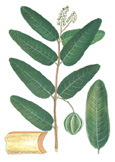| Latin Name | Terminalia arjuna (Roxb.) Wight & Arn. (Combretaceae) |
| English Name | Arjuna |
| Sanskrit Names | Arjunam Kakubha |
| Hindi Names | Arjun, Kahu |
 History: Physicians in ancient India were of the impression that the bark has some special virtue in promoting the union of fractures and the dispersion of ecchymosis when given internally. Distribution: Common in most parts of India and also planted in many parts for shade and ornament. Habit: T.a. is a large, evergreen tree, with a spreading crown and drooping branches. The stems are buttressed and often fluted; the bark is very thick, grey or pinkish green, smooth, exfoliating in large, thin, irregular sheets; the leaves are sub-opposite, oblong or elliptic, coriaceous, cordate; the flowers, in panicled spikes; the fruits are nearly glabrous, ovoid or ovoid-oblong, with 5-7 hard, winged angles. Principle constituents: ß-sitosterol, ellagic acid, and arjunic acid. Indications: The bark is useful as an anti-ischemic and cardioprotective agent in hypertension and ischemic heart diseases, especially in disturbed cardiac rhythm, angina or myocardial infarction. The bark powder possesses diuretic, prostaglandin enhancing and coronary risk factor modulating properties. It apparently has a diuretic and a general tonic effect in cases of cirrhosis of the liver. Product range: Abana, Geriforte, Liv-52, Pilex |
|